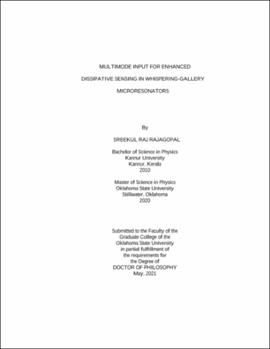| dc.contributor.advisor | Rosenberger, Albert T. | |
| dc.contributor.author | Rajagopal, Sreekul Raj | |
| dc.date.accessioned | 2021-09-23T19:42:42Z | |
| dc.date.available | 2021-09-23T19:42:42Z | |
| dc.date.issued | 2021-05 | |
| dc.identifier.uri | https://hdl.handle.net/11244/330836 | |
| dc.description.abstract | In this dissertation, we demonstrate a novel sensing technique for enhancing the sensitivity of dip-depth based dissipative sensing. First, we introduce two different sensing techniques (dispersive and dissipative) related to sensors based on optical whispering gallery mode (WGM) microresonators and show analytically that in an adiabatic tapered fiber coupled microresonator system, where a single mode is incident on the microresonator, the dissipative sensing based on the dip depth change can provide better sensitivity than dispersive sensing based on frequency shift measurements. However, the sensitivity can be further improved by making multiple fiber modes incident on the microresonator using an asymmetric tapered fiber. Next, the process of fabricating of asymmetric tapered fiber is explained and then an empirical model which predicts the radius of the fabricated asymmetric tapered fiber is developed. Based on the beat length measurements, the empirical model is validated and the correct delineation curve which determines the adiabaticity criteria is decided. Next, a simplified model which explains the behavior of an asymmetric tapered fiber coupled microresonator system is developed. Based on two experimentally determined input parameters, the model predicts the enhancement factor. In addition, the model allows us to compare the two dissipative sensing mechanisms, (based on fractional change in linewidth and fractional change in dip depth) and the absolute sensitivity of an asymmetric tapered fiber coupled microresonator system with multiple modes incident on the microresonator to the absolute sensitivity of an ideal adiabatic tapered fiber coupled microresonator system with a single mode incident on the microresonator. Finally, we show the experimental results which validate our model predictions; three orders of magnitude enhancement in dip depth sensing, two orders of magnitude more sensitivity in the dip depth based dissipative sensing signal compared to dissipative sensing signal based on the relative change in the linewidth, and the absolute sensitivity of an asymmetric tapered fiber coupled microresonator system with a quality factor (Q~10^7) is found to be comparable to the absolute sensitivity of an ideal adiabatic tapered fiber coupled microresonator system with a Q approximately equal to 10^9. | |
| dc.format | application/pdf | |
| dc.language | en_US | |
| dc.rights | Copyright is held by the author who has granted the Oklahoma State University Library the non-exclusive right to share this material in its institutional repository. Contact Digital Library Services at lib-dls@okstate.edu or 405-744-9161 for the permission policy on the use, reproduction or distribution of this material. | |
| dc.title | Multimode input for enhanced dissipative sensing in whispering-gallery microresonators | |
| dc.contributor.committeeMember | Summy, Gil | |
| dc.contributor.committeeMember | Borunda, Mario F. | |
| dc.contributor.committeeMember | West, James C. | |
| osu.filename | Rajagopal_okstate_0664D_17105.pdf | |
| osu.accesstype | Open Access | |
| dc.type.genre | Dissertation | |
| dc.type.material | Text | |
| dc.subject.keywords | dissipative sensing | |
| dc.subject.keywords | multimode | |
| dc.subject.keywords | non-adiabatic tapered fibers | |
| dc.subject.keywords | wgm sensors | |
| dc.subject.keywords | whispering gallery modes | |
| thesis.degree.discipline | Photonics | |
| thesis.degree.grantor | Oklahoma State University | |
